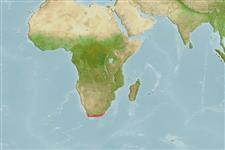Preferred temperature (Ref.
115969): 12.6 - 19.5, mean 16.3 (based on 19 cells).
Phylogenetic diversity index (Ref.
82804): PD
50 = 1.0000 [Uniqueness, from 0.5 = low to 2.0 = high].
Bayesian length-weight: a=0.01122 (0.00610 - 0.02063), b=3.03 (2.88 - 3.18), in cm Total Length, based on LWR estimates for this species & (Sub)family-body (Ref.
93245).
Trophic level (Ref.
69278): 3.5 ±0.5 se; based on size and trophs of closest relatives
устойчивость к внешним воздействиям (Ref.
120179): низкий, минимальное время удвоения популяции 4.5-14 лет (tm=5-6; tmax=27; K=0.07-0.08; Fec=11,000-1 million).
Prior r = 0.22, 95% CL = 0.15 - 0.33, Based on 2 full stock assessments.
Fishing Vulnerability (Ref.
59153): High to very high vulnerability (68 of 100).
Climate Vulnerability (Ref.
125649): Very high vulnerability (84 of 100).
